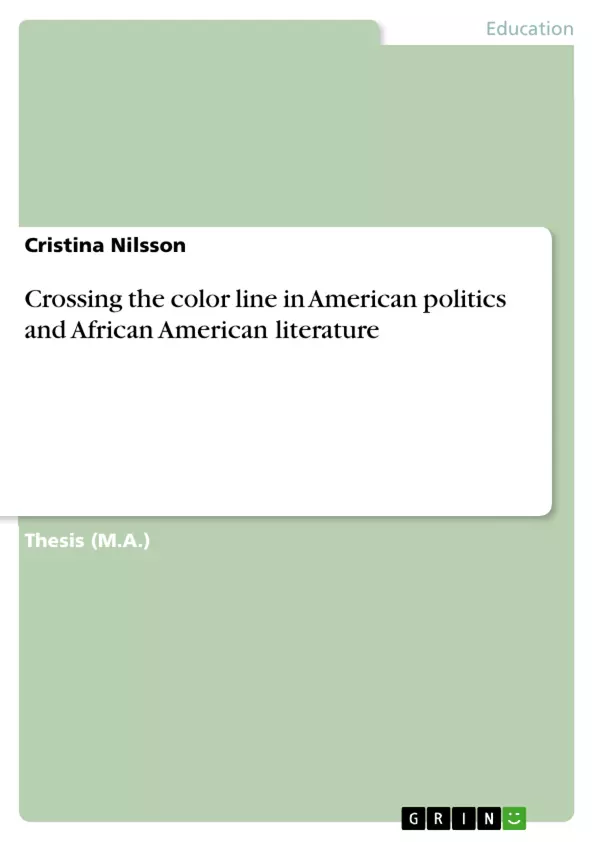My work will deal with some new and interesting subjects all united by a common thread: the color line. In the prologue I will dedicate a chapter to the importance of the Vernacular tradition, in particular the spirituals in African American history, from a linguistic point of view, then I will proceed with a historical part dedicated to a political background still to many unknown. In the first part of my work I will deal with the novel “The House Behind the Cedars” by Charles W. Chesnutt” within the context of a Jim Crow America. I will add a summary and a comment on the work, pointing out all those features directed to my thread “crossing the color line”. Then I will follow my thread by introducing the Harlem Renaissance through two of its main founders, Alain Locke and W.E.B. Dubois. The third part will be dedicated to “ Invisible Man” by Ralph Ellison within the historical discrimination context up to the Civil Rights movement. The last part will deal with Obama’s autobiography and election, using some interviews taken from Time.com and recent issues of international magazines.
I will try to prove in all parts of my work that if a crossing the color line was and still is in some periods of U.S. history more or less possible, it is still not possible to ignore all racial divisions. “Obama’s victory will not heal all differences, but has proved it can mobilize black and white Americans alike”.
The African Slaves who provided most of the labor that built the White House never imagined that a black man would ever own embossed stationery that reads 1600 Pennsylvania Avenue.
Even the dreamer himself, Dr. Martin Luther King Jr., would not have imagined that 40 short years after his assassination, America would be planning an Inauguration of the first man of African descent to ascend to its presidency.
No minority of any ethnicity had ever looked beyond the scarce representation of a few Senators and seen anything that suggested that the doorknob of the Oval Office could be opened by anything other than the hand of a middle-aged white male”.
According to T.D. Jakes, a writer and pastor at the Potter`s House church in Texas and producer of an upcoming film Not Easily Broken “the current economic crisis demands that the Obama Administration move past the pettiness of race matters with the haste of a paramedic driving an ambulance.
Inhaltsverzeichnis (Table of Contents)
- Introduction
- The Vernacular Tradition: The Spirituals as a milestone for African American Literature
- Reconstruction
- "The House behind the Cedars" by C.W. Chesnutt in the Jim Crow context
- The Harlem Renaissance through W.E.B. Dubois and Alain Locke
- "The Invisible Man" and Discrimination up to the Civil Rights movements
- From cultural to political color crossing: how Barack Obama can cope with the future without forgetting the past
- Conclusion
Zielsetzung und Themenschwerpunkte (Objectives and Key Themes)
This work aims to explore the concept of "crossing the color line" in American politics and African American literature. It examines how the line has been navigated throughout history, from the Vernacular tradition and the Jim Crow era to the Harlem Renaissance and Barack Obama's presidency.
- The role of the Vernacular tradition in shaping African American identity and culture
- The impact of Jim Crow laws and discrimination on African American life
- The significance of the Harlem Renaissance as a period of cultural and artistic expression
- The challenges and complexities of racial progress in the United States
- The significance of Barack Obama's presidency in the context of race relations
Zusammenfassung der Kapitel (Chapter Summaries)
- Introduction: This chapter sets the stage for the work, introducing the concept of "crossing the color line" and outlining the themes and topics that will be explored.
- The Vernacular Tradition: This chapter delves into the importance of the Vernacular tradition, particularly the spirituals, in African American history. It examines the tradition's significance as a form of cultural expression and its influence on African American literature.
- Reconstruction: This chapter explores the political context of Reconstruction and its impact on African American life. It provides a historical backdrop for the themes that will be discussed later in the work.
- "The House Behind the Cedars": This chapter analyzes Charles W. Chesnutt's novel "The House Behind the Cedars" within the context of Jim Crow America. It examines the novel's themes of racial identity, passing, and the struggle for equality.
- The Harlem Renaissance: This chapter focuses on the Harlem Renaissance, a period of cultural and artistic flourishing for African Americans. It examines the contributions of W.E.B. Dubois and Alain Locke, key figures in this movement.
- "The Invisible Man": This chapter explores Ralph Ellison's novel "Invisible Man" and its portrayal of discrimination against African Americans in the context of the Civil Rights movement.
- From Cultural to Political Color Crossing: This chapter analyzes Barack Obama's presidency and its significance in terms of race relations. It examines how Obama's election and leadership represent a milestone in American history.
Schlüsselwörter (Keywords)
The key concepts and themes explored in this work include: the Vernacular tradition, African American literature, Jim Crow, the Harlem Renaissance, racial discrimination, the Civil Rights movement, Barack Obama, and "crossing the color line".
- Quote paper
- Cristina Nilsson (Author), 2009, Crossing the color line in American politics and African American literature, Munich, GRIN Verlag, https://www.grin.com/document/162102



